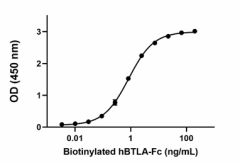- Regulatory Status
- RUO
- Other Names
- CD272, B- and T-lymphocyte attenuator, B- and T-lymphocyte-associated protein
- Ave. Rating
- Submit a Review
- Product Citations
- publications

-

Biotinylated recombinant human BTLA-Fc chimera binds to immobilized recombinant mouse HVEM at 0.05 µg/mL in a dose-dependent manner. The ED50 for this effect is 0.5 - 2.0 ng/mL. -

Stability Testing for Biotinylated Recombinant Human BTLA-Fc Chimera. Biotinylated recombinant human BTLA-Fc chimera was aliquoted in PBS, pH 7 at 0.2 mg/mL and one aliquot was kept at 4°C (Control), and another was frozen and thawed four times (4x Freeze/Thaw). After this procedure, the samples were tested for their ability to bind to immobilized recombinant mouse HVEM at 0.05 µg/mL in a dose-dependent manner. The ED50 for this effect is 0.5 - 2.0 ng/mL.
| Cat # | Size | Price | Quantity Check Availability | Save | ||
|---|---|---|---|---|---|---|
| 794904 | 25 µg | £197 | ||||
| 794906 | 100 µg | £586 | ||||
BTLA (B and T lymphocyte attenuator, CD272) is a type I transmembrane glycoprotein with four extracellular cysteine-rich domains. It is an inhibitory molecule structurally and functionally similar to cytotoxic T lymphocyte antigen-4 (CTLA-4) and programmed death-1 (PD-1). These molecules belong to the immunoglobulin superfamily that binds B7 family members. Different from CTLA-4 and PD-1 binding with the B7 family members, BTLA interacts with herpes virus entry mediator (HVEM/TNFRSF14) which belongs to TNFR family. BTLA/HVEM interaction was the first demonstration of crosstalk between these two family members. BTLA/HVEM interaction limits T cell activity in vivo and regulates the homeostatic expansion of CD4+ and CD8+ T cells. BTLA/HVEM interaction negatively modulates T cell activation. HVEM induces BTLA tyrosine phosphorylation and inhibits T-cell proliferation. There is accumulating evidence suggesting that BTLA/HVEM signaling also plays an important role in autoimmunity and infection at mucosal surfaces. The BTLA/HVEM interaction does not prevent the simultaneous binding of other HVEM ligands such as LIGHT/TNFSF14 or Lymphotoxin-alpha. BTLA is expressed on T cells, B cells, macrophages, dendritic cells, and natural killer cells. Constitutive expression level of BTLA on resting T cells are very low, but increase after the activation of T cells. BTLA is highly expressed on resting B cells.
Product DetailsProduct Details
- Source
- Human BTLA, amino acid (Lys31-Trp153) (Accession: Q7Z6A9.3), with a linker (GS), a C-terminal human IgG1 (Pro100-Lys330) and an Avi-tag, was expressed in CHO cells. Human BLTA-Avi tag was site-specifically biotinylated by enzyme BirA.
- Molecular Mass
- The 371 amino acid recombinant protein has a predicted molecular mass of approximately 42 kD. The DTT-reduced and non-reduced protein migrates at approximately 60 kD and 110 kD by SDS-PAGE, respectively. The predicted N-terminal amino acid is Lys.
- Purity
- > 95%, as determined by Coomassie stained SDS-PAGE
- Formulation
- 0.22 µm filtered protein solution is in pH 7.2, PBS, 5% glycerol.
- Endotoxin Level
- Less than 0.1 EU per µg protein as determined by the LAL method
- Concentration
- 25 µg size is bottled at 200 µg/mL. 100 µg size and larger sizes are lot-specific and bottled at the concentration indicated on the vial. To obtain lot-specific concentration and expiration, please enter the lot number in our Certificate of Analysis online tool.
- Storage & Handling
- Unopened vial can be stored between 2°C and 8°C for up to 2 weeks at -20°C for up to six months, or at -70°C or colder until the expiration date. For maximum results, quick spin vial prior to opening. The protein can be aliquoted and stored at -20°C or colder. Stock solutions can also be prepared at 50 - 100 µg/mL in appropriate sterile buffer, carrier protein such as 0.2 - 1% BSA or HSA can be added when preparing the stock solution. Aliquots can be stored between 2ᵒC and 8°C for up to one week and stored at -20°C or colder for up to 3 months. Avoid repeated freeze/thaw cycles.
- Activity
- Biotinylated recombinant human BTLA-Fc chimera binds to immobilized recombinant mouse HVEM at 0.05 µg/mL in a dose-dependent manner. The ED50 for this effect is 0.5 - 2.0 ng/mL.
- Application
-
Bioassay
- Application Notes
-
BioLegend carrier-free recombinant proteins provided in liquid format are shipped on blue-ice. Our comparison testing data indicates that when handled and stored as recommended, the liquid format has equal or better stability and shelf-life compared to commercially available lyophilized proteins after reconstitution. Our liquid proteins are validated in-house to maintain activity after shipping on blue ice and are backed by our 100% satisfaction guarantee. If you have any concerns, contact us at tech@biolegend.com.
Antigen Details
- Structure
- Disulfide bond-linked homodimer
- Distribution
-
Expressed in activated B, T (activated, memory), Th1, Th2 and Th17 Effector T-cells of patients with systemic lupus erythematosus, dendritic cells, macrophages, and hematopoietic stem cells
- Function
- B cell co-stimulation, proliferation and Ig production, limits T cell activity in vivo and homeostatic expansion of CD4+ and CD8+ T cells, NKT differentiation
- Interaction
- Lymphocytes
- Ligand/Receptor
- HVEM (TNFRSF14)
- Bioactivity
- Biotinylated recombinant human BTLA-Fc chimera binds to immobilized recombinant mouse HVEM in a dose-dependent manner.
- Antigen References
-
Watanabe N, et al. 2003. Nat. Immunol. 4:670.
1. Gavrieli M, et al. 2003. Biochem. Biophys. Res. Commun. 312:1236.
2. Gonzalez LC, et al. 2005. Proc. Natl. Acad. Sci. USA 102:1116.
3. Sedy JR, et al. 2005. Nat. Immunol. 6:90.
4. Kronenberg KM, et al., 2009. Proc. Natl. Acad. Sci. USA 106:6244.
5. Shui JW, et al., 2011. J. Leukoc. Biol. 89:517
6. Ofter C, et al., 2019, Int. J. Mol. Sci. 20:4505.
7. Yu X, et al., 2019. Front. Immunol. 10: 617. - Gene ID
- 151888 View all products for this Gene ID
- UniProt
- View information about BTLA on UniProt.org
 Login / Register
Login / Register 













Follow Us